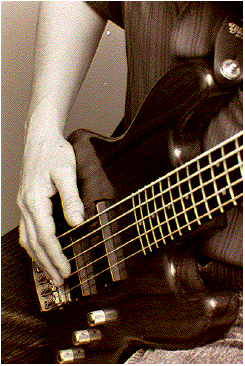
Keep your plucking hand in a relaxed natural position.
~ Right Hand Positioning ~
Just as
in the left hand, it is important to keep the wrist of the right hand
as straight as possible. The greater the angle of your wrist the greater
the friction on the tendons moving back and forth through the joint.
Rest your right hand in position on the bass. Don't even think about
playing. Do not flatten your palm across the bass strings. Allow the
tendons, muscles and elastin (the elastic connective tissue membrane
that connects all muscles, tendons and organs) to influence the natural
cupping position of your palm. Do not rest too heavily on the body of
the bass with the underside of your forearm. Doing so will restrict
blood flow and necessitate excessive bending of the wrist in order to
reach down for the strings. Such contortions will constrict tendon movement
and increase the probability of repetitive motion injury. To avoid this
underarm pressure on the bass, you will need to bring your elbow up
and slightly forward. This position will also enable you to straighten
you wrist. With the hand remaining in this relaxed position, move the
entire forearm either up to algin the finger tips with the E string
or down to algin the finger tips with the G string. You will notice
that your second finger extends further than your first finger. Slightly
bend the second joint of the second finger to bring the tip into line
with the tip of the first finger (see illustration B below). Now pluck
a string by using only the joint at the base of the finger joining the
palm. Using primarily the joint of your finger that joins the palm enables
you to maintain consistent alignment of the finger tips by not disturbing
the flex of the finger joints that help algin the finger tips. Play
into and across the string at about a 45 degree angle, resting the stroke
on the next string.